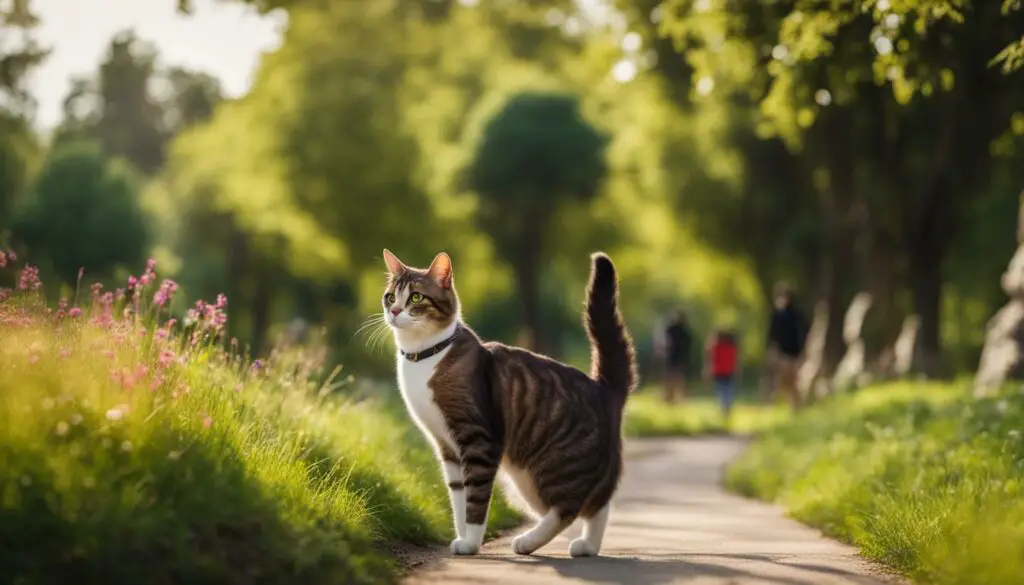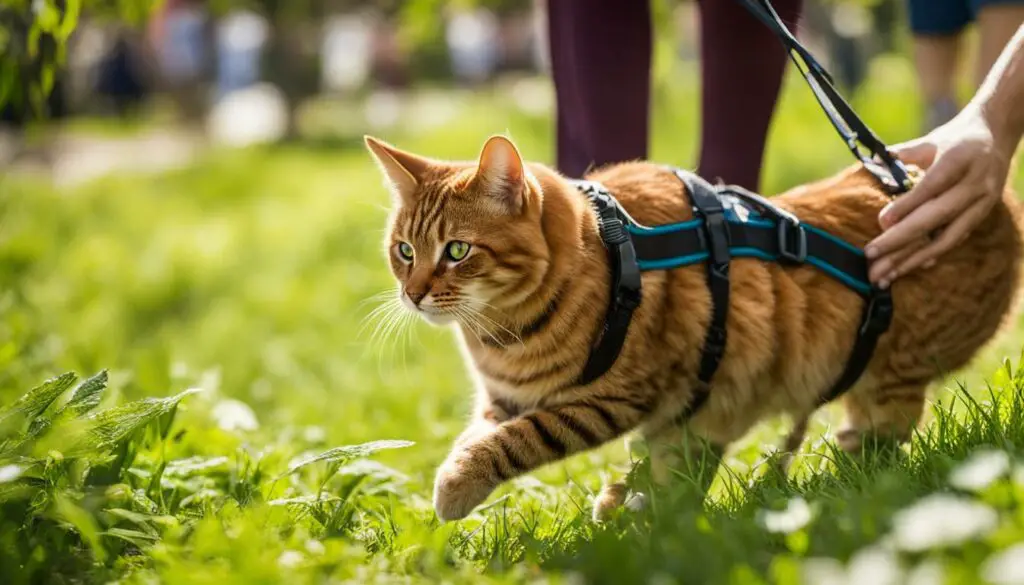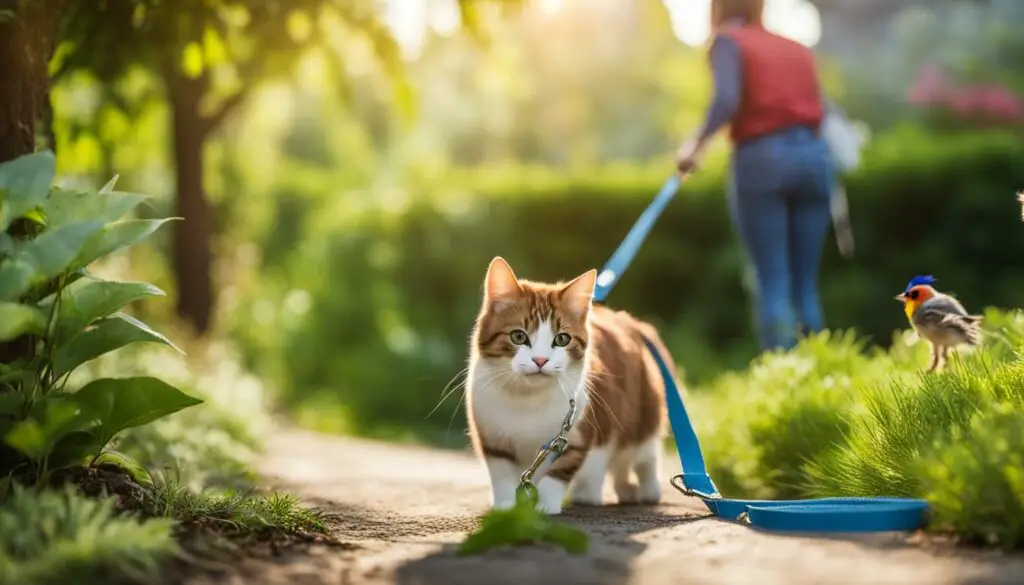Walking a cat can be a rewarding experience for both pet and owner. In this guide, I will share valuable tips and insights on how to walk a cat, from selecting the right harness and leash to training your feline companion. Whether you’re a beginner or looking to improve your cat walking skills, this guide has got you covered!
Key Takeaways:
- Walking a cat provides physical exercise and mental stimulation for your furry friend.
- Start slow and gradually introduce your cat to wearing a harness and leash.
- Choose a secure and comfortable harness designed specifically for cats.
- Leash train your cat with patience and positive reinforcement.
- Prioritize safety during walks and be attentive to your cat’s behavior.
The Benefits of Walking a Cat
Walking a cat provides numerous benefits for their physical and mental well-being. It helps to keep them active, maintain a healthy weight, and prevent obesity-related health issues. Cats are natural hunters, and walking allows them to engage their hunting instincts, providing valuable mental stimulation and enrichment. This helps reduce boredom and destructive behavior, as well as promote a sense of fulfillment for your feline companion.
Additionally, walking can strengthen the bond between cat and owner. Spending quality time together during walks allows for shared experiences and creates opportunities for positive interactions. As you walk alongside your cat, you’ll learn to understand their body language and cues, deepening your understanding and connection. The trust and mutual respect developed through regular walks can significantly enhance your relationship with your furry friend.
When walking a cat, it’s important to provide a safe and controlled environment. Choosing quiet and familiar outdoor locations minimizes stress and potential hazards. Walks also serve as an opportunity to expose your cat to new sights, sounds, and smells, enriching their sensory experiences. The fresh air and exercise provided during walks contribute to your cat’s overall health and well-being, ensuring they lead a happy and balanced life.

Getting Started: Cat Walking Tips for Beginners
If you’re new to cat walking, it’s important to start slowly and gradually introduce your cat to the experience. Walking a cat is a unique and enriching activity that can provide both physical exercise and mental stimulation for your feline friend. To help you get started on the right paw, here are some cat walking tips for beginners.
Indoor Preparation
Begin by getting your cat comfortable with wearing a harness and leash indoors. Choose a harness that fits securely but allows for natural movement. Introduce the harness gradually, allowing your cat to get used to wearing it for short periods of time. Use positive reinforcement such as treats and praise to create positive associations with the harness.
Choose the Right Location
When you’re ready to venture outdoors, select a quiet and safe location for your first walks. Avoid busy roads or areas with potential hazards. This will help reduce distractions and ensure the safety of your cat. Keep a close eye on your cat’s behavior and body language, and be prepared to end the walk if your cat shows signs of stress or discomfort.
Positive Reinforcement
During your walks, use positive reinforcement to reward your cat for walking calmly and following your cues. Carry treats with you and offer them as a reward for good behavior. This will help create a positive association with the walking experience and encourage your cat to continue walking alongside you.
| Cat Walking Tips for Beginners |
|---|
| Start indoors by getting your cat comfortable with wearing a harness and leash. |
| Choose a quiet and safe outdoor location for your first walks. |
| Monitor your cat’s behavior closely and end the walk if necessary. |
| Use positive reinforcement, such as treats, to reward your cat for good behavior. |

Remember, every cat is unique, and it may take some time for them to adjust to walking on a leash. Patience and consistency are key. Consult with a veterinarian for additional guidance and to ensure the safety and well-being of your cat. With practice and positive reinforcement, you and your feline companion can enjoy the many benefits of walking together.
Selecting the Right Cat Walking Harness and Leash
When it comes to walking your cat, choosing the right harness and leash is essential for a safe and comfortable experience. A cat walking harness is different from a regular harness, as it is specifically designed to provide more control and prevent your cat from slipping out. Look for a harness that is comfortable and adjustable, allowing for a secure fit without restricting your cat’s natural movement.
Avoid using a collar for cat walking, as it can put pressure on their neck and potentially cause injuries. Instead, opt for a harness that distributes the pressure evenly across their chest and shoulders. This will ensure that your cat is comfortable and allows for better control during walks.

Pairing the right harness with a suitable leash is equally important. Choose a lightweight leash that is long enough to give your cat some freedom to explore, but not too long that it becomes difficult to control. A retractable leash can be a good option, as it allows you to adjust the length as needed.
Table: Comparison of Cat Walking Harnesses
| Brand | Material | Adjustability | Size Options | Price |
|---|---|---|---|---|
| PetSafe | Nylon | Yes | Small, Medium, Large | $20 |
| Kitty Holster | Cotton | Yes | One Size Fits Most | $25 |
| Puppia Soft Vest | Polyester | Yes | Small, Medium, Large | $15 |
When selecting a cat walking harness, consider factors such as the material, adjustability, size options, and price. It’s important to find a harness that suits your cat’s size and needs. Some popular brands to consider include PetSafe, Kitty Holster, and Puppia Soft Vest.
By carefully choosing the right cat walking harness and leash, you’ll be well-prepared to embark on enjoyable and safe walks with your feline companion.
Training Your Cat to Walk on a Leash
Leash training your cat can be a rewarding experience that allows them to explore the outdoors while ensuring their safety. It may take time and patience, but with the right approach, you can successfully train your cat to walk on a leash. Here are some tips to help you get started:
- Introduce the harness gradually: Begin by letting your cat sniff and investigate the harness before attempting to put it on. Reward them with treats and praise for positive behavior.
- Proper fitting is essential: Ensure that the harness fits your cat comfortably and securely. You should be able to fit two fingers between the harness and your cat’s body. Avoid any restrictive or uncomfortable tightness.
- Practice indoors: Once your cat is comfortable wearing the harness, attach a lightweight leash and let them drag it around the house. This will help them get accustomed to the sensation of being on a leash.
- Start with short walks: When you’re ready to venture outdoors, choose a quiet and familiar area for your cat’s first walks. Keep the initial walks short and gradually increase the duration as your cat becomes more comfortable.
- Use positive reinforcement: Reward your cat with treats and praise for walking calmly and following your cues. This will help create positive associations with the leash and walking experience.
- Be patient and consistent: Leash training takes time, so be patient with your cat and provide consistent training sessions. Remember that each cat learns at their own pace.
It’s important to note that not all cats will take to leash training, and some may never be comfortable with it. If your cat shows signs of fear or stress during the training process, it’s best to respect their boundaries and find alternative ways to provide exercise and enrichment.
By following these steps and maintaining a positive and patient attitude, you can increase the chances of success in leash training your cat. Remember to prioritize your cat’s comfort and well-being throughout the process, and enjoy the special bond that walking together can bring.

Safety Precautions for Cat Walking
When it comes to cat walking, ensuring the safety of your furry friend is paramount. By taking certain precautions, you can make each walking experience enjoyable and secure for both you and your cat.
Harness Fit and Security
One of the most important safety measures is to ensure that your cat’s harness fits properly and is securely fastened. A well-fitted harness will prevent your cat from escaping or slipping out during walks. It’s essential to regularly check the harness for any signs of wear and tear, such as frayed straps or loose buckles. If you notice any damage, replace the harness immediately to maintain optimal safety.
Additionally, getting your cat accustomed to wearing a harness indoors before venturing outside can help them feel more comfortable and prevent resistance or panic during walking sessions.
Choose Safe Walking Environments
When selecting a location for your cat’s walk, prioritize safety by avoiding busy roads or areas with potential hazards. Opt for quiet and peaceful outdoor spaces where your cat can explore and enjoy their surroundings without unnecessary stress or danger. Keeping a watchful eye on your cat’s behavior and staying alert to any signs of distress or discomfort is crucial.
Protection from Parasites
Protecting your cat from external parasites is another vital aspect of cat walking safety. Regularly apply flea and tick prevention treatments as recommended by your veterinarian. These preventive measures will help safeguard your cat from potentially harmful pests that they may encounter during walks.
| Safety Precautions for Cat Walking |
|---|
| Harness Fit and Security |
| Choose Safe Walking Environments |
| Protection from Parasites |
By following these safety precautions, you can ensure that your cat walking adventures are enjoyable, secure, and beneficial for both you and your feline companion.

Engaging Your Cat During Walks
Walking a cat is not just about physical exercise; it’s also an opportunity for mental stimulation and enrichment. During your walks, engage your cat by allowing them to explore their surroundings and follow their natural instincts. Encourage them to sniff, investigate, and even climb if it’s safe to do so. This sensory experience can be highly engaging for cats, providing them with mental stimulation and a chance to satisfy their curiosity.
To make the walk more interactive and exciting for your cat, consider bringing along some toys or treats. Interactive toys, such as feather wands or puzzle toys, can keep your cat entertained and engaged during the walk. You can also use treats to reward good behavior and encourage your cat to stay focused and attentive.
Additionally, it’s important to ensure your cat stays hydrated during the walk, especially on hot days. Bring a collapsible water bowl and offer water breaks if needed. Keeping your cat hydrated is essential for their overall well-being and comfort.
Remember, each cat is unique, so pay attention to their individual preferences and adjust your approach accordingly. Some cats may be more interested in exploring their environment, while others may prefer interactive play sessions. The key is to provide a variety of engaging activities that cater to your cat’s specific interests and needs.
| Engaging Your Cat During Walks | Benefits |
|---|---|
| Allowing your cat to explore their surroundings | Provides mental stimulation and enrichment |
| Bringing interactive toys or treats | Keeps your cat entertained and engaged |
| Offering water breaks | Ensures your cat stays hydrated |
| Adjusting activities based on your cat’s preferences | Ensures engagement and enjoyment |
Cat Walking Tips for Success
Walking a cat can be a wonderful experience, but it may also come with its challenges. Here are some useful tips to troubleshoot common cat walking challenges and ensure a successful and enjoyable outing with your feline friend:
1. Introduce the harness gradually:
Some cats may initially resist wearing a harness. Take it slow and introduce the harness gradually, allowing your cat to get used to the sensation. Start by leaving the harness near their favorite sleeping spot or rubbing it with their scent to familiarize them with it. Gradually progress to putting the harness on for short periods indoors before attempting outdoor walks.
2. Be patient and reward positive behavior:
Cat walking requires patience and positive reinforcement. Reward your cat with treats and praise when they exhibit calm behavior and follow your cues. Associating the harness and leash with positive experiences will help your cat develop a positive association and make the walking experience more enjoyable for both of you.
3. Choose the right walking environment:
Select a quiet and familiar outdoor location for your walks, especially when starting out. Avoid crowded or noisy areas that may overwhelm or startle your cat. Gradually expose them to different environments and increase the level of stimulation as they become more comfortable and confident during walks.
4. Stay attuned to your cat’s cues:
Pay close attention to your cat’s body language during walks. If they seem stressed, anxious, or show signs of discomfort, it’s important to respect their boundaries and end the walk if necessary. Every cat is unique, and some may require more time and patience to adjust to walking outdoors.
By following these cat walking tips, you can overcome common challenges and make the experience enjoyable for both you and your feline companion. Remember, each cat is an individual, and it’s important to tailor your approach to their specific needs and comfort levels.

Table: Common Cat Walking Challenges and Solutions
| Challenge | Solution |
|---|---|
| Resistance to wearing a harness | Introduce the harness gradually and associate it with positive experiences |
| Distracted or frightened behavior | Choose quiet and familiar outdoor locations, gradually expose them to different environments |
| Signs of stress or discomfort | Respect your cat’s boundaries, end the walk if necessary |
| Non-compliance or pulling on the leash | Use positive reinforcement techniques and reward calm behavior |
Incorporating Walking into Your Cat’s Routine
Walking your cat can be a wonderful addition to their daily routine, providing them with exercise, mental stimulation, and quality time with you. To incorporate walking into your cat’s routine, follow these simple steps:
Step 1: Start Slowly
Begin by introducing your cat to the idea of walking gradually. Allow them to sniff and explore their walking harness indoors, rewarding them with treats and praise for positive associations. Once they are comfortable with the harness, you can proceed to the next step.
Step 2: Choose the Right Time and Place
Pick a quiet and safe outdoor location for your walks, away from busy roads and potential dangers. Start with short walks, gradually increasing the duration as your cat becomes more confident. Walking early in the morning or in the evening can help avoid extreme temperatures and ensure a more comfortable experience for your cat.
Step 3: Use Positive Reinforcement
During your walks, use positive reinforcement to encourage your cat to walk alongside you. Reward them with treats and praise for calm behavior and for following your cues. This will help reinforce their walking behavior and make the experience enjoyable for both of you.
| Walking Tips | Benefits |
|---|---|
| Start slowly and gradually. | Physical exercise for your cat. |
| Choose a quiet and safe outdoor location. | Mental stimulation and enrichment. |
| Use positive reinforcement and rewards. | Improved bond between cat and owner. |
By following these steps, you can easily incorporate walking into your cat’s routine and provide them with the exercise and mental stimulation they need. Remember to always prioritize your cat’s safety and enjoyment during the walks. Happy walking!

Indoor Exercise Alternatives for Cats
While outdoor walks can provide great exercise and stimulation for cats, they may not always be feasible or suitable for every cat. Fortunately, there are plenty of indoor exercise alternatives that can help keep your cat active and engaged.
1. Provide a variety of toys: Offering a range of toys can help keep your cat entertained and encourage physical activity. Interactive toys, such as feather wands or laser pointers, can provide mental stimulation while keeping your cat moving.
2. Set up climbing structures: Cats love to climb and explore. Invest in a sturdy cat tree or create vertical spaces by installing shelves or perches. These structures provide opportunities for exercise and give your cat a sense of ownership over their environment.
3. Introduce puzzle feeders: Instead of placing your cat’s food in a regular bowl, use puzzle feeders to make mealtime more engaging. These feeders require your cat to work for their food, stimulating their natural hunting instincts and providing mental and physical exercise.
| Exercise Alternative | Description |
|---|---|
| Interactive play sessions | Engage in play sessions with your cat using toys like feather wands or laser pointers. This will provide mental stimulation and encourage physical activity. |
| Obstacle courses | Create indoor obstacle courses using tunnels, boxes, and other safe objects for your cat to navigate through. This can provide both physical and mental exercise. |
| Scratching posts | Provide multiple scratching posts throughout your home to promote healthy scratching behavior and stretching. This can help keep your cat’s muscles toned. |
Remember to rotate toys and rearrange climbing structures periodically to keep your cat’s interest. Always prioritize your cat’s safety by ensuring that any equipment or toys are secure and free from hazards. By incorporating these indoor exercise alternatives into your cat’s routine, you can help keep them active, happy, and mentally stimulated.
My Favorite Indoor Exercise Activity: Hide and Seek
A fun and interactive game to play with your cat indoors is hide and seek. Find a few of your cat’s favorite treats or small toys and hide them in different areas of your home. Encourage your cat to explore and search for the hidden treasures. This game provides mental stimulation and engages your cat’s natural hunting instincts. It’s a great way to bond with your feline friend while providing exercise at the same time.
Cat Walking and Bonding with Your Pet
Walking a cat not only provides physical exercise but also strengthens the bond between you and your pet. It’s a wonderful opportunity to spend quality time together and create lasting memories. As you walk side by side, you’ll learn to understand your cat’s body language and cues, deepening your connection and mutual trust.
During your walks, take the time to show your cat affection and offer praise and reassurance. Use gentle guidance and positive reinforcement to encourage them to walk alongside you. This positive interaction will foster a sense of security and strengthen your bond.
Additionally, walking a cat allows you to explore new environments together. Whether it’s a peaceful park or a bustling neighborhood, the shared experience of discovering new sights, sounds, and smells can be enriching for both you and your cat. It’s a chance to stimulate their curious nature and provide mental stimulation during the walk.
Remember, every cat is unique, and some may take longer to adjust to walking than others. Be patient, understanding, and attentive to your cat’s needs. The goal is to create a positive and enjoyable experience that enhances your bond and enriches your lives.

Table: How Cat Walking Enhances Bonding
| Benefits | Explanation |
|---|---|
| Quality time together | Walking provides dedicated one-on-one time, strengthening the bond between you and your cat. |
| Understanding body language | Walking allows you to observe and interpret your cat’s body language, enhancing communication and understanding. |
| Mutual trust | Through positive reinforcement and guidance, walking promotes trust and builds a stronger relationship. |
| Shared exploration | Discovering new environments together stimulates curiosity and provides mental stimulation for your cat. |
Special Considerations for Senior Cats
When it comes to walking senior cats, it’s important to take their age and physical condition into consideration. While walking can still be beneficial for older cats, it’s essential to consult with your veterinarian to ensure it’s appropriate for your furry friend. Some health conditions, such as arthritis or heart disease, may limit their ability to engage in rigorous physical activity.
The duration and intensity of walks should be adjusted to accommodate the needs of senior cats. Start with shorter walks and monitor your cat for signs of discomfort or fatigue. It’s crucial to be observant and responsive to your cat’s cues during the walk. Allow them to set the pace and provide breaks when needed. Remember, the overall goal is to maintain their health and well-being, so it’s essential to prioritize their comfort and safety.
In addition to adjusting the walking routine, there are other ways to ensure senior cats get the exercise they need. Engage them in interactive play sessions indoors using toys that stimulate both their physical and mental abilities. Consider setting up an indoor obstacle course or using puzzle feeders to provide mental stimulation. These alternatives can help keep senior cats active and engaged, even if outdoor walks are limited.

By tailoring the walking routine to meet the unique needs of senior cats, you can help them maintain their health and enjoy their golden years to the fullest. Whether it’s a leisurely stroll in the garden or a gentle indoor exercise session, the key is to provide opportunities for physical and mental stimulation that are safe and enjoyable for your senior feline companion.
Conclusion
After exploring the world of walking cats, I have discovered the numerous benefits it brings to both pets and owners. Walking a cat provides essential exercise, helps maintain a healthy weight, and prevents potential health issues. It also stimulates their minds, reducing boredom and destructive behaviors. Plus, it strengthens the bond between you and your furry friend, creating a trusting and loving relationship.
If you are new to cat walking, remember to start slowly and gradually introduce your cat to the experience. Be patient and use positive reinforcement to encourage them. Choose the right harness and leash, ensuring a secure fit that allows natural movement. Safety is always paramount, so be cautious of potential hazards and signs of stress or discomfort.
Walking a cat is not only about physical exercise but also about engaging their senses. Let your feline friend sniff, investigate, and climb when safe. Bring along interactive toys and collapsible water bowls to keep them entertained and hydrated. And remember, even if outdoor walks are not possible, there are plenty of indoor exercise alternatives to keep your cat active and happy.
So, embark on this wonderful journey of cat walking and witness the positive impact it has on your pet’s well-being. Enjoy the quality time spent together, show your cat affection, and build a deep bond that will last a lifetime. Happy walking!
FAQ
Is it possible to walk a cat?
Yes, it is possible to walk a cat. While cats are independent animals, many can enjoy the experience of walking with their owners.
What are the benefits of walking a cat?
Walking a cat provides physical exercise, mental stimulation, and helps strengthen the bond between cat and owner.
How do I get started with cat walking?
Start slowly by getting your cat comfortable with wearing a harness and leash indoors before venturing outside. Choose a quiet and safe location for your first walks.
What type of harness and leash should I use?
Opt for a harness specifically designed for cats that provides control and prevents slipping. Pair it with a lightweight and retractable leash.
How do I train my cat to walk on a leash?
Introduce the harness gradually, reward positive behavior, and practice walking indoors before transitioning to outdoor walks.
How can I ensure the safety of my cat while walking?
Ensure that the harness fits properly and securely, avoid busy roads or hazards, and monitor your cat’s behavior for signs of stress or discomfort.
How can I engage my cat during walks?
Allow them to explore, carry interactive toys or treats, and provide water breaks if needed.
What if my cat faces challenges during walks?
Take it slow, reward positive behavior, and find a quiet and familiar area to build their confidence. Adjust your walking routine based on your cat’s cues.
How can I incorporate walking into my cat’s routine?
Establish a routine by walking at the same time each day, start with shorter walks, and gradually increase the duration.
Are there indoor exercise alternatives for cats?
Yes, provide toys, scratching posts, and climbing structures, engage in interactive play sessions, and set up indoor obstacle courses or puzzle feeders.
Can cat walking strengthen the bond with my pet?
Yes, walking together allows for quality one-on-one time, positive interactions, and helps build trust and mutual respect.
What considerations should I take into account for senior cats?
Consult with your veterinarian to ensure walking is appropriate for your senior cat, adjust the duration and intensity, and be observant of signs of discomfort or fatigue.






